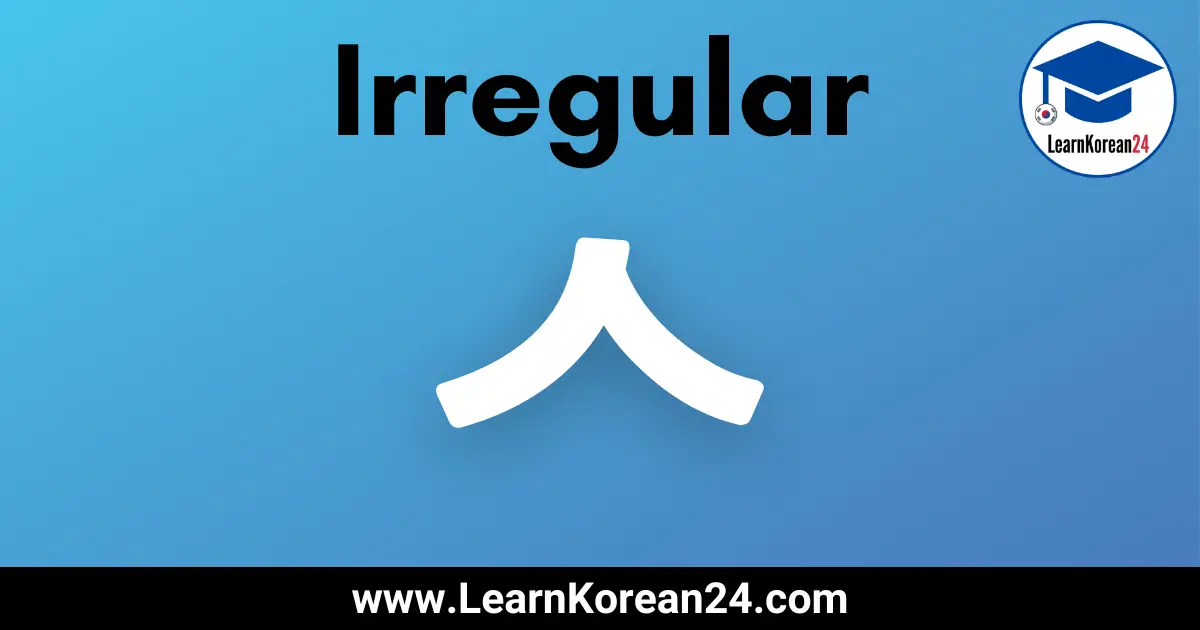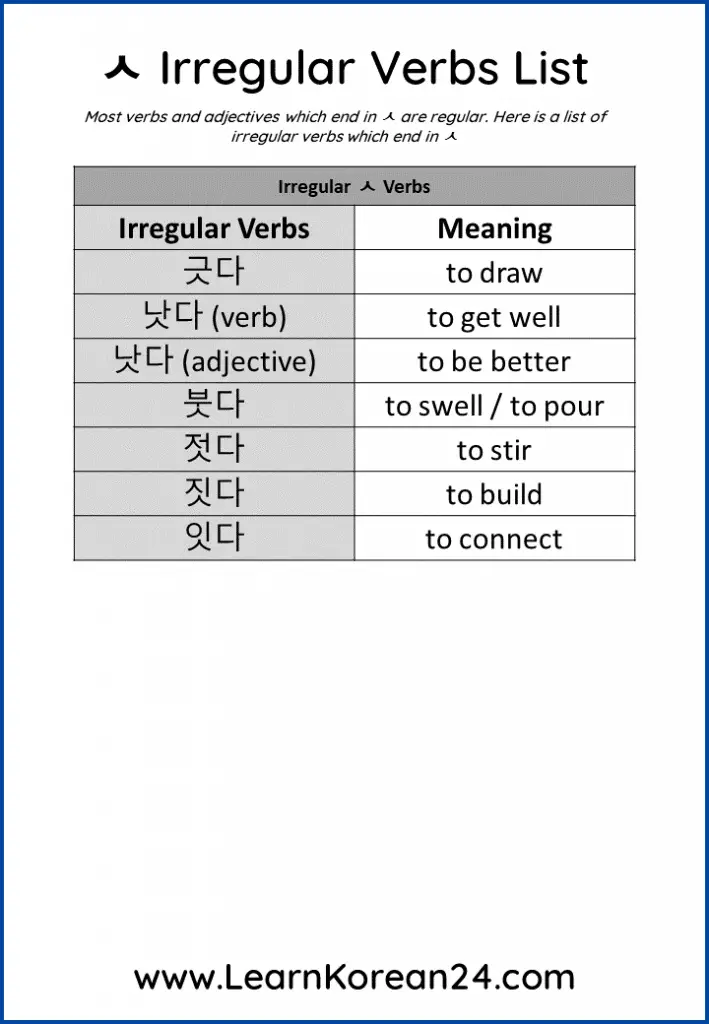Irregular Korean Verbs With ㅅ (ㅅ 불규칙)
In this lesson, you will learn about ㅅ irregular verbs (ㅅ 불규칙). In Korean, most verbs and adjectives which end in ㅅ are not irregular, and so they are conjugated the same as regular verbs and adjectives.
However, there are some verbs and adjectives which end in ㅅ that are irregular. As such, it is important to learn which Korean verbs ending in ㅅ are irregular, and how to conjugate ㅅ irregular verbs.
Below you will find a ㅅ irregular verb list and you will learn how to conjugate ㅅ irregular verbs.
ㅅ Irregular Verbs (ㅅ 불규칙)
As was mentioned above, most verbs and adjectives which end in ㅅ are not irregular. In fact, there are only a few ㅅ irregular verbs. To help you learn which ㅅ verbs and adjectives are irregular we have put together a useful list of ㅅ irregular verbs.
ㅅ Irregular Verbs List
- 긋다 = to draw
- 낫다 = to get well (verb) / to be better (adj)
- 붓다 = to pour / swell
- 젓다 = to stir
- 짓다 = to build
- 잇다 = to connect
How To Conjugate ㅅ Irregular Verbs (ㅅ 불규칙)
Of the seven irregular verb forms in Korean, ㅅ irregular verbs are one of the easiest to learn as they have the fewest conjugation rules to remember.
Here are the conjugation rules to follow when conjugating ㅅ irregular verbs in Korean.
Rule 1
Irregular ㅅ verbs and adjectives only behave irregularly when conjugated with endings that start with a vowel.
For example, endings such as 아요/어요 (present tense), ~(으)면 ( if), etc, start with a vowel, and so when these endings are attached to irregular ㅅ verbs, these verbs behave irregularly.
With other endings that start with a consonant, for example (e.g. (스)ㅂ니다, irregular ㅅ verbs and adjectives do not behave irregularly. That is, they are conjugated just the same as regular verbs.
Rule 2
When conjugating ㅅ irregular verbs with endings that start with a vowel, ㅅ is always dropped from the verb stem.
For example, 긋다 (to draw) + 아요/어요 = 그어요. This is because ㅅ is dropped from the verb stem before adding 아요/어요.
Rule 3
Vowels do not combine when conjugating ㅅ irregular verbs.
Usually when conjugating Korean words, when vowels meet, they are combined. For example, 마시다 (to drink) + 아요/어요 (present tense) = 마셔요 (NOT 마시어요). This is because the vowel ㅣ from the verb stem and the vowel ㅓ from the ending combine to make ㅕ.
However, when conjugating irregular ㅅ verbs, the vowels do not combine. Here are some examples:
짓다 + 어요 = 지어요 (NOT 져요)
낫다 + 아요 = 나아요 (NOT 나요)
ㅅ Irregular Examples
Here are some examples of ㅅ irregular verbs conjugated with some common endings. After reading these examples, if you’re not sure why they are conjugated in this way, please re-read the conjugation rules above.
| ㅅ Irregular Verb | 아요/어요 (present Tense) | (으)세요 (Imperative) | (스)ㅂ니다 (Formal Ending) |
|---|---|---|---|
| 긋다 (to draw) | 그어요 | 그으세요 | 긋습니다 |
| 낫다 (to get well / to be better) | 나아요 | 나으세요 | 낫습니다 |
| 붓다 (to pour) | 부어요 | 부으세요 | 붓습니다 |
| 젓다 (to stir) | 저어요 | 저으세요 | 젓습니다 |
| 짓다 (to build) | 지어요 | 지으세요 | 짓습니다 |
| 잇다 (to connect) | 이어요 | 이으세요 | 잇습니다 |
As you can see in the table above, when the ㅅ irregular verbs are conjugated with endings which start with a vowel (아요/어요, (으)세요) the verb behaves irregularly. And so, ㅅ is dropped from the verb stem and the vowels do not combine.
With the ending starting with a consonant ( (스)ㅂ니다 ), the verbs do not behave irregularly. And so the verb stem does not change and ㅅ is not dropped.
ㅅ Irregular Example Sentences
Here are some ㅅ Irregular example sentences:
- 한국에서는 아파트를 많이 지어요. (짓다) = In Korea, they build lots of apartments.
- 저는 책을 읽을 때 단어에 밑줄을 그어요. (긋다) = When I read books, I underline the words.
- 밤늦게 라면을 먹으면 다음날 얼굴이 부어요. (붓다) = If you eat noodles late at night, you will have a swollen face the next day.
More Korean Irregular Verb Lessons
There are seven types of irregular verbs in Korean. For more lessons on Korean Irregular verbs, click on the links below.
ㅂ Irregular
ㅡ Irregular
르 Irregular
ㄷ Irregular
ㄹ Irregular
ㅅ Irregular
ㅎ Irregular



